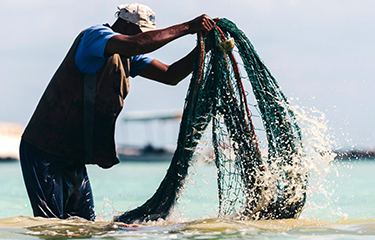Climate patterns across various ocean regions have impacted the production, survival, and performance of fish, fisheries, and aquaculture – which in turn directly impacts the populations that rely on the resource for a living.
A new report published by the Food and Agriculture Organization (FAO), in partnership with French National Research Institute for Sustainable Development (IRD France), says the events of El Niño and La Niña – which are recurring climate patterns made of warm and cool phases across the tropical Pacific, popularly known as the El Niño-Southern Oscillation (ENSO) – “generally worsen the effects of climate change on fish, fisheries, and aquaculture.”
The report, which has been developed from various existing documented sources on ENSO events, says the impacts of both El Niño and La Niña, when looked at cumulatively across the globe, may appear weak – until one analyzes the effects at regional and local levels.
“Although El Niño events are considered to be dramatic for marine fisheries in some parts of the world, on average ENSO results in changes of global marine catches of only about one percent relative to neutral years,” the report says. “Marine landings were indeed approximately 0.7 million [metric tons (MT)] lower during El Niño and 1.3 million [MT] higher during La Niña years when compared with the mean landings in the absence of an ENSO event.”
The severity of these effects on fish, fisheries, and aquaculture largely depends on the ENSO type. The report lists the five types, which includes Extreme El Niño, Moderate Eastern Pacific (EP) El Niño, Moderate Central Pacific (CP) El Niño, Coastal El Niño, and strong La Niña.
For example, the strongest negative effect for extreme El Niño and for EP El Niño could be a reduction of up to 3.2 million MT and 0.6 million MT of marine landings respectively, although there was “no significant effect during CP El Niño.”
The report points out the ENSO impacts are much lower when the Peruvian anchovy is excluded, the situation changes with the extreme El Niño occurrences when a mean deficit of 480,000 MT has been reported.
“The eastern Pacific extreme or EP El Niño events have been demonstrated to have major effects on nutrient structure (via alteration of upwelling), primary production, and higher trophic levels, leading to changes in fishing rates,” the report says.
However, within the Western Indian Ocean (WIO) region, the report indicates the “ENSO impacts on fishery landings are weak, with an average negative anomaly of approximately 16,000 [MT] during El Niño.”
The negative effect in that region was felt much more during the extreme El Niño, when an average reduction of up to 53,000 MT was reported, and also during the CP El Niño, when the decline was around 21,000 MT. This is unlike during the EP El Niño, when a positive impact was reported of 25,000 MT. That demonstrates that while the global impacts of ENSO events may be weak, it can have severe affects on specific regions depending on the El Niño type.
Moreover, many people within the WIO and Indian Ocean Small Island Developing States (SIDS) rely on seafood for up 90 percent of their animal protein requirements, hence the concerns about the negative impacts of the ENSO events on fisheries there.
“Even in a continental country such as Mozambique, where there are 90,000 fishers, it is estimated that 50 percent of the population’s protein intake comes from fish,” it adds.
The El Niño phenomenon also greatly influence tropical cyclones, or typhoons, which in turn alter the migration of the demersal species and cause the destruction of fishing gear – such as boats, engines, fish aggregating devices, and coastal facilities.
Fishing patterns in areas prone to the ENSO events are also affected, as is the post-harvest handling of captured and farmed fish within each region which demonstrate varied responses in coping with this natural occurrence.
Within the Benguela upwelling ecosystem – which includes South Africa, Namibia, and Angola – the El Niño events tend to increase the catch for anchovy species “while sardine (Sardinops sagax) catches improve after La Niña events, with both responses having a delay of several months.”
Overall, the report says there is no “clear impact of ENSO on fish and fisheries of the southeast Atlantic Ocean,” although countries in this region have already embraced coping mechanisms that largely focus more on climate change and other extreme events.
For example, in Southern Africa the Benguela Current Commission has previously been established by Angola, Namibia, and South Africa to implement a 2015-2020 FAO and Global Environment Facility-supported project “to enhance climate change resilience by influencing fisheries policies and planning.”
Proposed measures, including those already being implemented, include “encouraging diversification, introducing insurance schemes, strengthening harbor defenses, and using alternative fishing gear to target alternative species such as when sardine abundance is low, the sardine fisheries could target more abundant anchovies by midwater trawling.”
For governments and the seafood industry, it is encouraging that key coping and adaptation measures taken previously in any given ocean region have easily been tailored to suit any “ENSO event types and to the existing institutional and socio-economic context.”
Destruction of coral reefs due to the ENSO events and persistent global warming continues to impact the fish supply chain across the global ocean regions, according to various studies used in production of the report.
The report calls for interventions hinged on “institutional adaptation, livelihoods adaption, and risk reduction and management for resilience” for success. It says for all ocean regions “building capacity is imperative.”
The lack of follow-ups on previously reported successful interventions makes it difficult to conclude with precision which of the interventions should be prescribed as the best option in mitigating the effects of the ENSO events.
Nevertheless, the report reiterates the importance of “assessing past and ongoing efforts” in addressing the effects of the ENSO events on fish, fisheries, and aquaculture.
Photo courtesy of the African Development Bank







